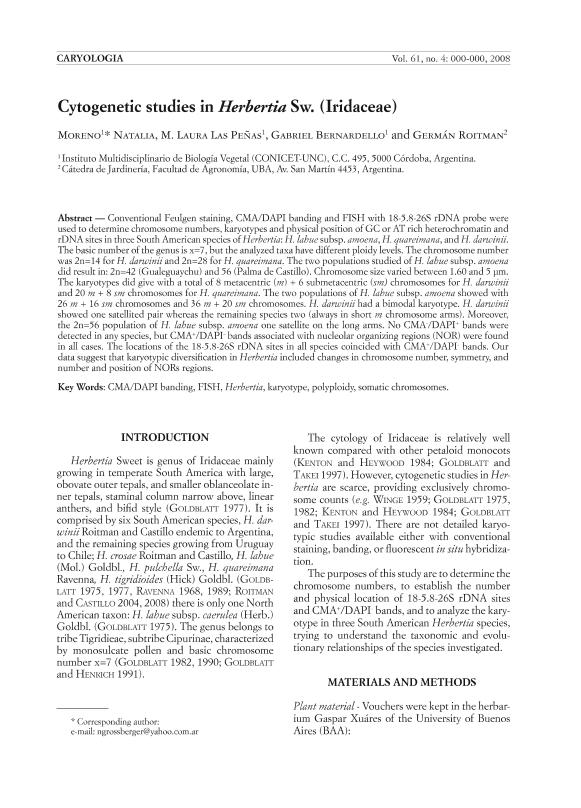Artículo
Cytogenetic studies in herbertia sw. (iridaceae)
Moreno, Natalia Cecilia ; Las Peñas, Maria Laura
; Las Peñas, Maria Laura ; Bernardello, Gabriel Luis Mario
; Bernardello, Gabriel Luis Mario ; Roitman, Germán
; Roitman, Germán
 ; Las Peñas, Maria Laura
; Las Peñas, Maria Laura ; Bernardello, Gabriel Luis Mario
; Bernardello, Gabriel Luis Mario ; Roitman, Germán
; Roitman, Germán
Fecha de publicación:
12/2009
Editorial:
University Florence Botany Institute
Revista:
Caryologia
ISSN:
0008-7114
e-ISSN:
2165-5391
Idioma:
Inglés
Tipo de recurso:
Artículo publicado
Clasificación temática:
Resumen
Conventional Feulgen staining, CMA/DAPI banding and FISH with 18-5.8-26S rDNA probe were used to determine chromosome numbers, karyotypes and physical position of GC or AT rich heterochromatin and rDNA sites in three South American species of Herbertia: H. lahue subsp. amoena, H. quareimana, and H. darwinii. The basic number of the genus is x=7, but the analyzed taxa have different ploidy levels. The chromosome number was 2n=14 for H. darwinii and 2n=28 for H. quareimana. The two populations studied of H. lahue subsp. amoena did result in: 2n=42 (Gualeguaychu) and 56 (Palma de Castillo). Chromosome size varied between 1.60 and 5 µm. The karyotypes did give with a total of 8 metacentric (m) + 6 submetacentric (sm) chromosomes for H. darwinii and 20 m + 8 sm chromosomes for H. quareimana. The two populations of H. lahue subsp. amoena showed with 26 m + 16 sm chromosomes and 36 m + 20 sm chromosomes. H. darwinii had a bimodal karyotype. H. darwinii showed one satellited pair whereas the remaining species two (always in short m chromosome arms). Moreover, the 2n=56 population of H. lahue subsp. amoena one satellite on the long arms. No CMA- /DAPI+ bands were detected in any species, but CMA+/DAPI– bands associated with nucleolar organizing regions (NOR) were found in all cases. The locations of the 18-5.8-26S rDNA sites in all species coincided with CMA+/DAPI- bands. Our data suggest that karyotypic diversification in Herbertia included changes in chromosome number, symmetry, and number and position of NORs regions.
Palabras clave:
CMADAPI BANDING
,
FISH
,
HERBERTIA
,
KARYOTYPE
,
POLYPLOIDY
,
SOMATIC CHROMOSOMES
Archivos asociados
Licencia
Identificadores
Colecciones
Articulos(IMBIV)
Articulos de INST.MULTIDISCIPL.DE BIOLOGIA VEGETAL (P)
Articulos de INST.MULTIDISCIPL.DE BIOLOGIA VEGETAL (P)
Citación
Moreno, Natalia Cecilia; Las Peñas, Maria Laura; Bernardello, Gabriel Luis Mario; Roitman, Germán; Cytogenetic studies in herbertia sw. (iridaceae); University Florence Botany Institute; Caryologia; 62; 1; 12-2009; 37-42
Compartir
Altmétricas



